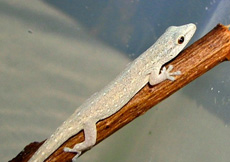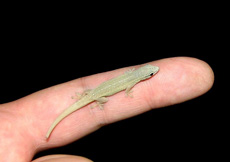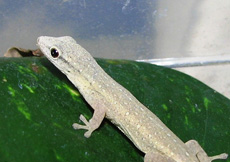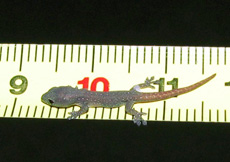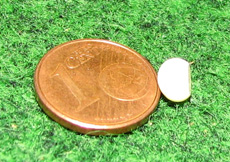Lygodactylus cf. conraui
Distribution:
The exact native location of this Lygodactylus type is not known. I know it only from an import coming from Tanzania. It must be assumed that the exact origin of these dwarf geckos is not necessarily located in Tanzania itself, but that the animals were captured in neighboring countries.
Description:
The normal coloring of this animal is varying shades of gray. Starting from the nostril a black stripe runs across the snout onward throughout the eye up to the back of the head. This line eventually fades to a lighter color at the neck and runs down the sides and ends high up on the back side of the tail. Beginning at the nape the entire body, with the exclusion of the limbs is adorned with large irregular spots. These spots are often framed by a thin black line. The biggest spots line up alongside three longitudinal lines, which run on the center of the back along with the lighter lines. While the gecko is in a happy state the gecko's skin is often noted to glow a bluish green color. The throat and belly are uniformly colored in light gray to white. Original tails of males are a reddish hue on the underside of the tail. While regenerated tails are completely gray with no red tint. Regenerated tail tips however can have this reddish tint under the tail. Males have a total length of 6,3 centimeters, while females remain far smaller. The sexes are subject to the usual sexual characteristics, males are always larger, and have clear Hemipenis pockets. They have four active preanal pores.
Lygodactylus cf. conraui normally has a total length of up to 10 centimeters, while the animals described here have only a total length of 6.3 centimeters.
Habitat:
Unfortunately nothing is known about the natural habitat of Lygodactylus cf. conraui.
Husbandry and Breeding:
For the well being of these quite small stick tailed geckos a terrarium measuring 25x40x40 centimeters (roughly 10 gallons) or larger for a pair would be sufficient. The terrarium should be decorated with small sticks or bamboo. The substrate can be a fine play sand or coconut humus. A small potted plant should also be offered. The lighting should be a small compact UVB bulb. Heating in the form of 20 watt halogen puck lights helps maintain temperatures of 25-28°C (77-82°F). The basking area may safely reach 32°C (90°F).
Food for Lygodactylus cf. conraui is similar to that of other Lygodactylus.
Provided the proper care is maintained Lygodactylus cf. conraui will readily reproduce. The females usually lay a double clutch, but sometimes there may only be one egg. Eggs will be laid in an appropriate place selected by the female, most commonly inside bamboo. Lygodactylus cf. conraui is an egg-gluer. So one should never try to loosen the eggs. Doing so almost always results in damaging the eggs. Eggs are 5mm in diameter. Should the female lay in bamboo it is possible however to transfer them to an incubator. Provided with a constant temperature of 25°C (77°F) the eggs hatch around 80 days. When incubated at 28°C (82°F) the incubation period is decreased to around 60 days. Left in the terrarium to incubate, temperatures ranging from 20-27°C (68-81°F) exhibit hatching results around 82 days. On hatching the young measure a total length of 2.4 centimeters. The hatchlings share the same coloring and patterns as the adults except their tails will be tinted brown.
Due to their very small size the hatchlings can be housed in modified 1 liter household containers. Decoration consists of small sticks or bamboo tubes. A small plant should also not be missing. Substrate and lighting for the hatchlings should be the same as the adults. Experience has shown that young Lygodactylus thrive better in rearing boxes that were previously used by other hatchlings. This could be because previous inhabitants leave behind healthy intestinal flora.
The diet of Lygodactylus cf. conraui hatchlings should consist of micro food. Pinhead crickets, springtails, woodlice and small Drosophila to name a few, are gladly accepted. In addition you can also offer the young fruit puree. The food should be dusted with the appropriate vitamins at each feeding.
Lygodactylus cf. conraui become sexually mature around 1 year, however it is not to rare that males will mature more quickly, so they should be separated as soon as the sex of the animals is determined.
